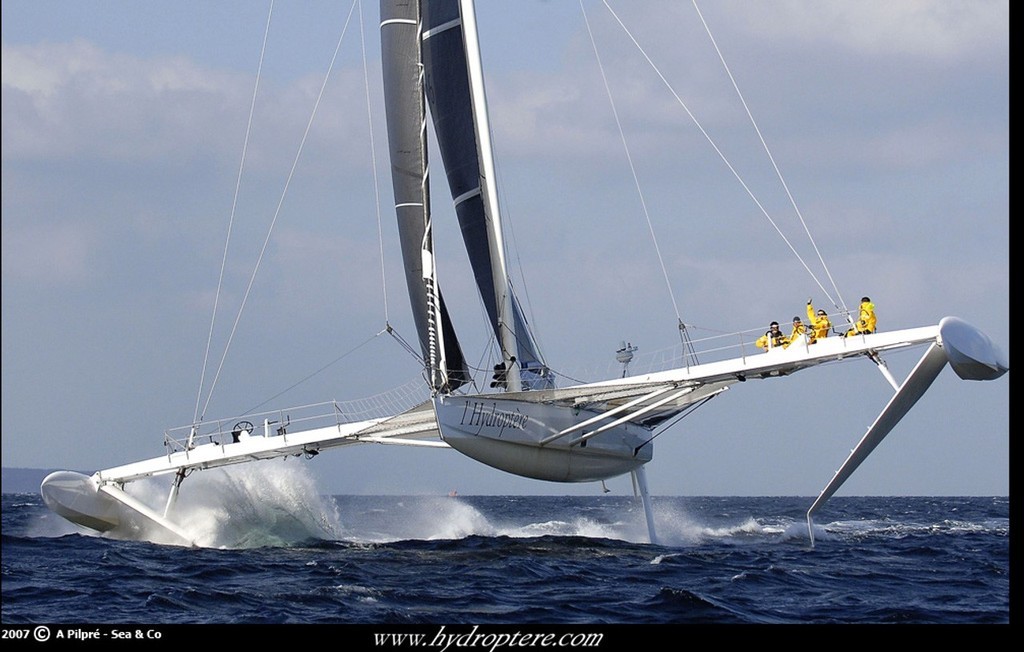Round the World by sailing boat in 40 days? Is it possible?
by Simon Bradley, swissinfo.ch/Sail-World on 17 Apr 2009

Hydroptere Hydroptere.com
http://www.Hydroptere.com
That is what a revolutionary Franco-Swiss 'flying yacht' project aims to achieve, and the project has entered a new phase.
So far, the solo record is held by Francis Joyon at 57 days, and the fastest crewed round world record is 50 days by Bruno Peyron. These are both Frenchmen, so it seems if anyone is going to cut 10 days off the current record, it just might be the French.
Experts at Lausanne's Federal Institute of Technology (EPFL) on Wednesday presented to the media a small prototype catamaran which they are helping to develop. It is based on the Hydroptère hydrofoil vessel – the world's fastest sailing boat.
The new test boat, known as Hydroptère.ch, will serve as a model for a future giant catamaran, Hydroptère Maxi, which will aim to beat the current round-the-world records.
'We would like to go around the world in 40 days within the next two or three years,' Alain Thébault, the 46-year-old Breton who is the brains and the driving force behind the Hydroptère, told swissinfo.
Thébault has been obsessed by the idea of a flying boat since he was a child and came up with an initial concept in 1975. Twelve years later, he started working on the Hydroptère.
In 2005 EPFL President Patrick Aebischer and Geneva banker and sailing enthusiast Thierry Lombard came on board the project.
Travelling more than twice as fast as a single-hull sailboat such as Alinghi, the existing 18-metre-long Hydroptère – 'water wing' in Greek – already has several world speed records to her name. In 2008 it became the first sailing boat to break the magic 50-knot (92.6km/h) speed barrier and then topped 100 km/h, travelling at up to 56.3 knots (i.e. 104 km/h).
The Hydroptère concept is to minimise the friction from the water and waves. With the wind blowing at only 12 knots, the hull of the 24.5-metre wide vessel lifts almost 1.5 metres above the water, skimming the surface of the waves with the tips of her wings.
These two hydrofoils set at angles on the Hydroptère's arms provide side stability, while a foil on the rear of the central hull acts as the rudder. An onboard computer linked to sensors analyses stress on the hull, hydrofoils and other components.
When the boat is 'flying', only two square metres are in touch with water.
'Making the boat fly is relatively simple, but keeping it stable is complicated and getting it to fly fast through big waves demands a great deal of work,' said Thébault.
Fast floating lab
'The new Hydroptère.ch will be a floating laboratory which travels extremely quickly,' said EPFL head of communications Nicolas Henchoz.
The 11-metre-long hydrofoil prototype will be based in Lausanne, close to Hydroptère's EPFL design team, which is in charge of her development. The EPFL has been the official scientific adviser to the project since 2006.
Work on the new prototype started at the beginning of 2009 at the B&B shipyard in La Trinité sur Mer, France, and at Décision SA in Ecublens, near Lausanne – both specialists in composite materials.
Décision SA helped build the America's Cup defender Alinghi and the Solar Impulse, Betrand Piccard's solar plane.
The new project will build on existing hydrofoil developments and test new materials, designs and boat behaviour in real conditions on Lake Geneva, with a view to building Hydroptère Maxi in the next two or three years.
'The new boat will be a concentrated version of the existing Hydroptère, which is 14 years old now. But quite a lot of changes have taken place since then, especially in terms of composite materials,' said Daniel Schmäh, a former EPFL student who is part of the design team.
Weak points
The test team will also work on the boat's weak points, like its performance at lower wind speeds, and try to resolve problems like cavitation. This is a phenomenon that occurs when a hydrofoil moves fast through the water, causing bubbles to form around it which threaten to eliminate all lift and stop the yacht in its tracks.
The catamaran will have a central structure and V-shaped foils, like the existing boat. It will also be fitted with a central rudder so it can sail with the foils out of the water when conditions are not favourable for take off.
The boat will be equipped with a central electronic unit to accurately record adjustments and stress on the foils, hull and rigging, and to provide weather data.
A crew of five to six sailors will test the catamaran on Lake Geneva from the beginning of next year since it offers a stretch of water with extremely varied wind conditions.
Dream come true?
For EPFL students the partnership with Hydroptère is a dream come true, said Jan-Anders Manson, the project's scientific coordinator at EPFL.
'It stimulates students and focuses interest on fundamental research questions; this is extremely important for us,' he told swissinfo.
Schmäh nodded in agreement: 'This is the kind of project you dream about as a student. You work on a specific case and apply theoretical research from your studies. The time between carrying out research and actually applying it is very short and you see the results immediately.'
EPFL students are particularly involved in computer modelling and optimising production processes.
Such tools will help identify the overall design and the sailing limitations of Hydroptère.ch and maybe define the future of sailing, say the scientists.
'Hydroptère Maxi is set to revolutionise sailing,' said chief researcher Jean-Mathieu Bourgeon. 'Modern sailing boats already offer extremely high performances, but in the future all boats will fly on the water.'
If you want to link to this article then please use this URL: www.sailworldcruising.com/55887